Employee Exposure to Thermal Stressors: OSH4308 Unit 5 Project Report
VerifiedAdded on 2023/06/09
|8
|1894
|497
Project
AI Summary
This project report, prepared for Columbia Southern University's OSH4308 course, assesses employee exposure to thermal stressors at Acme Manufacturing Company. The study investigates the impact of heat and cold stress on security personnel, calculating wind chill factors and Wet Bulb Globe Temperatures (WBGT) to evaluate workplace conditions. The report categorizes employees based on their exposure levels (too much heat, too much cold, normal temperature), detailing the associated health risks, such as dehydration, heat exhaustion, and hypothermia. The findings reveal significant health effects due to extreme temperature exposure, leading to recommendations for both cold and heat exposure control measures, including engineering, administrative, and personal protective equipment solutions. These recommendations aim to mitigate risks, improve working conditions, and enhance employee productivity. The project includes detailed calculations for wind chill and WBGT, supporting the conclusions and proposed solutions. The report concludes with a call to action for Acme Manufacturing Company and its employees to implement these precautions to ensure proper working conditions and minimize exposure to thermal stressors.
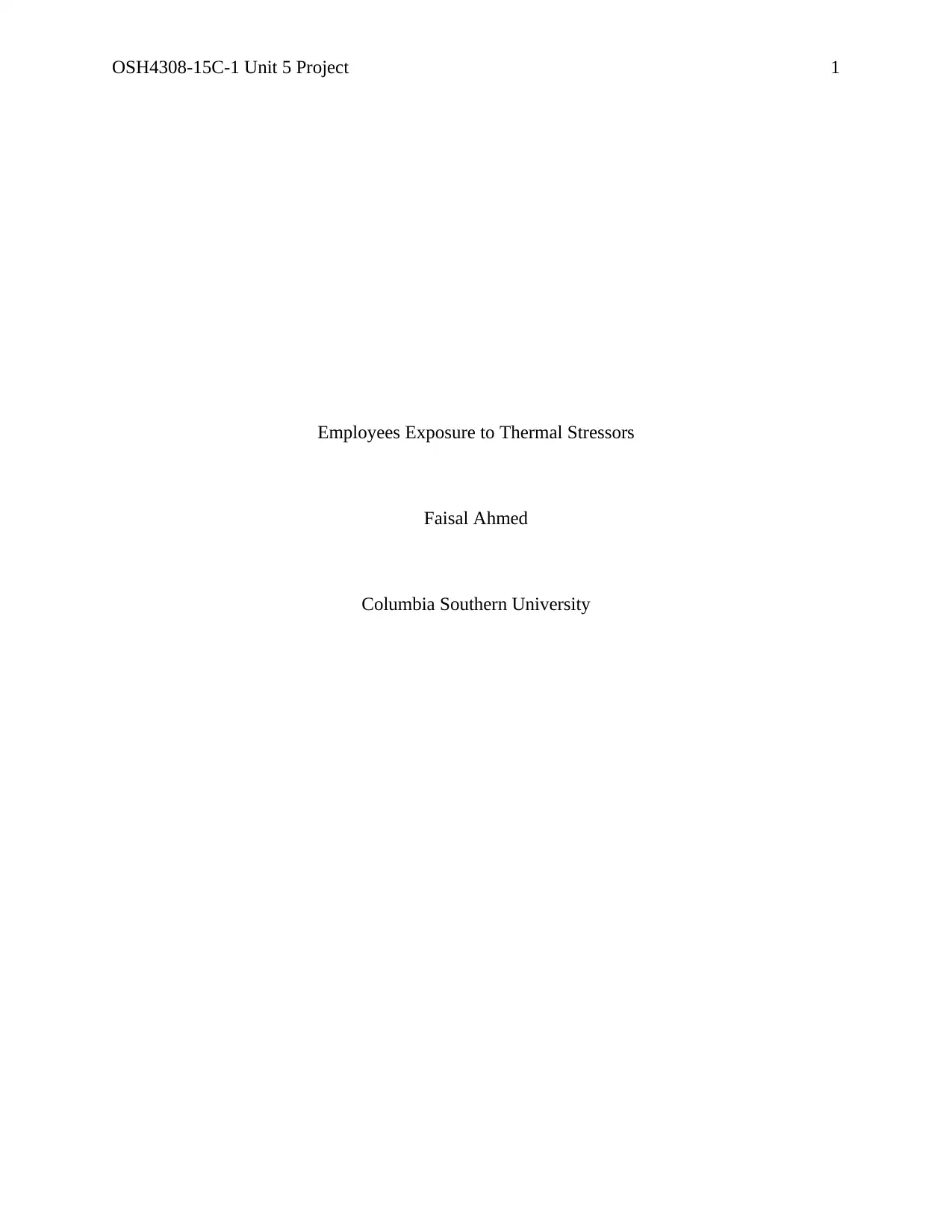
OSH4308-15C-1 Unit 5 Project 1
Employees Exposure to Thermal Stressors
Faisal Ahmed
Columbia Southern University
Employees Exposure to Thermal Stressors
Faisal Ahmed
Columbia Southern University
Paraphrase This Document
Need a fresh take? Get an instant paraphrase of this document with our AI Paraphraser
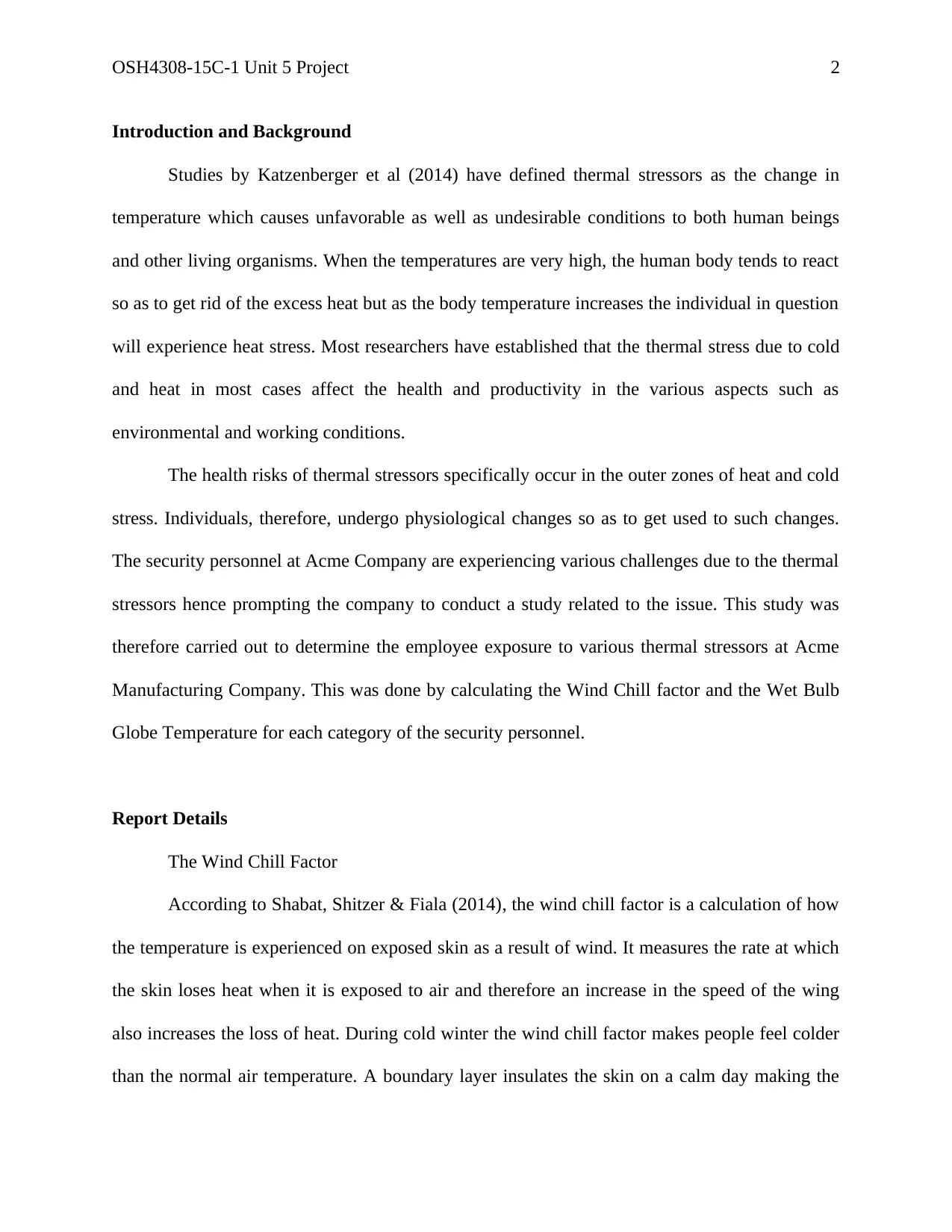
OSH4308-15C-1 Unit 5 Project 2
Introduction and Background
Studies by Katzenberger et al (2014) have defined thermal stressors as the change in
temperature which causes unfavorable as well as undesirable conditions to both human beings
and other living organisms. When the temperatures are very high, the human body tends to react
so as to get rid of the excess heat but as the body temperature increases the individual in question
will experience heat stress. Most researchers have established that the thermal stress due to cold
and heat in most cases affect the health and productivity in the various aspects such as
environmental and working conditions.
The health risks of thermal stressors specifically occur in the outer zones of heat and cold
stress. Individuals, therefore, undergo physiological changes so as to get used to such changes.
The security personnel at Acme Company are experiencing various challenges due to the thermal
stressors hence prompting the company to conduct a study related to the issue. This study was
therefore carried out to determine the employee exposure to various thermal stressors at Acme
Manufacturing Company. This was done by calculating the Wind Chill factor and the Wet Bulb
Globe Temperature for each category of the security personnel.
Report Details
The Wind Chill Factor
According to Shabat, Shitzer & Fiala (2014), the wind chill factor is a calculation of how
the temperature is experienced on exposed skin as a result of wind. It measures the rate at which
the skin loses heat when it is exposed to air and therefore an increase in the speed of the wing
also increases the loss of heat. During cold winter the wind chill factor makes people feel colder
than the normal air temperature. A boundary layer insulates the skin on a calm day making the
Introduction and Background
Studies by Katzenberger et al (2014) have defined thermal stressors as the change in
temperature which causes unfavorable as well as undesirable conditions to both human beings
and other living organisms. When the temperatures are very high, the human body tends to react
so as to get rid of the excess heat but as the body temperature increases the individual in question
will experience heat stress. Most researchers have established that the thermal stress due to cold
and heat in most cases affect the health and productivity in the various aspects such as
environmental and working conditions.
The health risks of thermal stressors specifically occur in the outer zones of heat and cold
stress. Individuals, therefore, undergo physiological changes so as to get used to such changes.
The security personnel at Acme Company are experiencing various challenges due to the thermal
stressors hence prompting the company to conduct a study related to the issue. This study was
therefore carried out to determine the employee exposure to various thermal stressors at Acme
Manufacturing Company. This was done by calculating the Wind Chill factor and the Wet Bulb
Globe Temperature for each category of the security personnel.
Report Details
The Wind Chill Factor
According to Shabat, Shitzer & Fiala (2014), the wind chill factor is a calculation of how
the temperature is experienced on exposed skin as a result of wind. It measures the rate at which
the skin loses heat when it is exposed to air and therefore an increase in the speed of the wing
also increases the loss of heat. During cold winter the wind chill factor makes people feel colder
than the normal air temperature. A boundary layer insulates the skin on a calm day making the
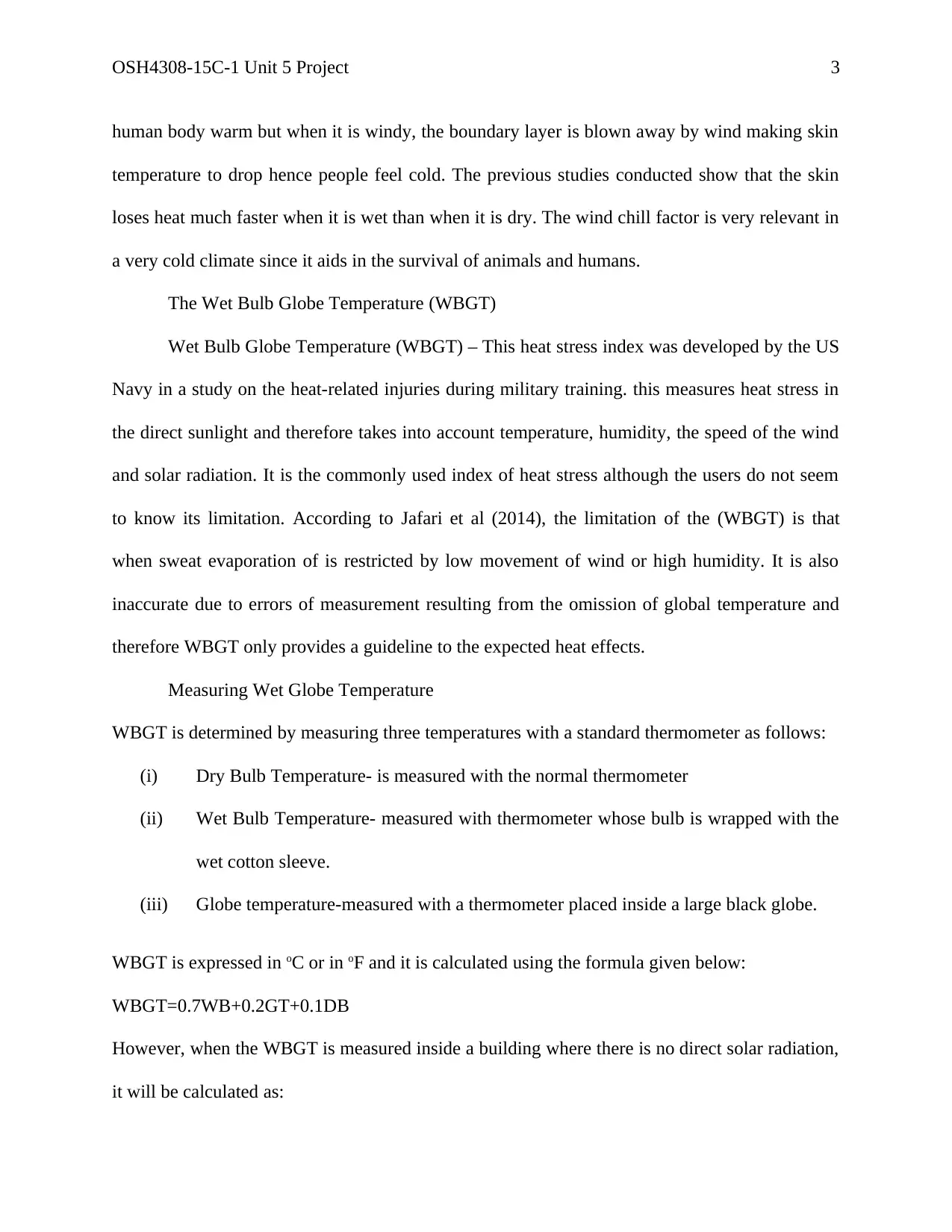
OSH4308-15C-1 Unit 5 Project 3
human body warm but when it is windy, the boundary layer is blown away by wind making skin
temperature to drop hence people feel cold. The previous studies conducted show that the skin
loses heat much faster when it is wet than when it is dry. The wind chill factor is very relevant in
a very cold climate since it aids in the survival of animals and humans.
The Wet Bulb Globe Temperature (WBGT)
Wet Bulb Globe Temperature (WBGT) – This heat stress index was developed by the US
Navy in a study on the heat-related injuries during military training. this measures heat stress in
the direct sunlight and therefore takes into account temperature, humidity, the speed of the wind
and solar radiation. It is the commonly used index of heat stress although the users do not seem
to know its limitation. According to Jafari et al (2014), the limitation of the (WBGT) is that
when sweat evaporation of is restricted by low movement of wind or high humidity. It is also
inaccurate due to errors of measurement resulting from the omission of global temperature and
therefore WBGT only provides a guideline to the expected heat effects.
Measuring Wet Globe Temperature
WBGT is determined by measuring three temperatures with a standard thermometer as follows:
(i) Dry Bulb Temperature- is measured with the normal thermometer
(ii) Wet Bulb Temperature- measured with thermometer whose bulb is wrapped with the
wet cotton sleeve.
(iii) Globe temperature-measured with a thermometer placed inside a large black globe.
WBGT is expressed in oC or in oF and it is calculated using the formula given below:
WBGT=0.7WB+0.2GT+0.1DB
However, when the WBGT is measured inside a building where there is no direct solar radiation,
it will be calculated as:
human body warm but when it is windy, the boundary layer is blown away by wind making skin
temperature to drop hence people feel cold. The previous studies conducted show that the skin
loses heat much faster when it is wet than when it is dry. The wind chill factor is very relevant in
a very cold climate since it aids in the survival of animals and humans.
The Wet Bulb Globe Temperature (WBGT)
Wet Bulb Globe Temperature (WBGT) – This heat stress index was developed by the US
Navy in a study on the heat-related injuries during military training. this measures heat stress in
the direct sunlight and therefore takes into account temperature, humidity, the speed of the wind
and solar radiation. It is the commonly used index of heat stress although the users do not seem
to know its limitation. According to Jafari et al (2014), the limitation of the (WBGT) is that
when sweat evaporation of is restricted by low movement of wind or high humidity. It is also
inaccurate due to errors of measurement resulting from the omission of global temperature and
therefore WBGT only provides a guideline to the expected heat effects.
Measuring Wet Globe Temperature
WBGT is determined by measuring three temperatures with a standard thermometer as follows:
(i) Dry Bulb Temperature- is measured with the normal thermometer
(ii) Wet Bulb Temperature- measured with thermometer whose bulb is wrapped with the
wet cotton sleeve.
(iii) Globe temperature-measured with a thermometer placed inside a large black globe.
WBGT is expressed in oC or in oF and it is calculated using the formula given below:
WBGT=0.7WB+0.2GT+0.1DB
However, when the WBGT is measured inside a building where there is no direct solar radiation,
it will be calculated as:
⊘ This is a preview!⊘
Do you want full access?
Subscribe today to unlock all pages.

Trusted by 1+ million students worldwide

OSH4308-15C-1 Unit 5 Project 4
WBGT= 0.7 WB+0.3GT
The findings of the study reveal that the employees experience varying temperatures in
the workplace. The findings are categorized into three groups.
i) Category one: Too much heat
The first category of employees works under conditions of too much heat which causes
excessive loss of fluids and fatigue as well as mental and physical effects. The stress resulting
from too much heat poses a serious threat to these employees whereby their economic well-
being, health as well as social situation exposes them to extreme temperature and other related
cases of such exposure. Some of the dangers faced by the workers due to heat exposure are three
major varieties which include dehydration, heat exhaustion, the heat cramps, and possibly heat
stroke which deadly.
When the employees experience heat stress as well as dehydration, the will have
difficulty in concentration as well as difficulty in performing tasks since they become tired faster
than in normal temperature conditions which can eventually lead to hypothermia.
Hypothermia- this is a result of extreme elevation in temperature or excessive exposure to heat
which require urgent medical attention and can lead to death.
ii) Category two: Too much Cold
The second group of employees works under very cold conditions. In this case, the wind
speed may be greater than the value of the wind chill factor. This, therefore, requires that the
workers take breaks at work and rest in an enclosed environment which is adequately heated.
The security personnel also dress appropriately to protect themselves from the wind. These
workers also wear gloves, hats and extra socks. Although they do not have adequate provision
WBGT= 0.7 WB+0.3GT
The findings of the study reveal that the employees experience varying temperatures in
the workplace. The findings are categorized into three groups.
i) Category one: Too much heat
The first category of employees works under conditions of too much heat which causes
excessive loss of fluids and fatigue as well as mental and physical effects. The stress resulting
from too much heat poses a serious threat to these employees whereby their economic well-
being, health as well as social situation exposes them to extreme temperature and other related
cases of such exposure. Some of the dangers faced by the workers due to heat exposure are three
major varieties which include dehydration, heat exhaustion, the heat cramps, and possibly heat
stroke which deadly.
When the employees experience heat stress as well as dehydration, the will have
difficulty in concentration as well as difficulty in performing tasks since they become tired faster
than in normal temperature conditions which can eventually lead to hypothermia.
Hypothermia- this is a result of extreme elevation in temperature or excessive exposure to heat
which require urgent medical attention and can lead to death.
ii) Category two: Too much Cold
The second group of employees works under very cold conditions. In this case, the wind
speed may be greater than the value of the wind chill factor. This, therefore, requires that the
workers take breaks at work and rest in an enclosed environment which is adequately heated.
The security personnel also dress appropriately to protect themselves from the wind. These
workers also wear gloves, hats and extra socks. Although they do not have adequate provision
Paraphrase This Document
Need a fresh take? Get an instant paraphrase of this document with our AI Paraphraser
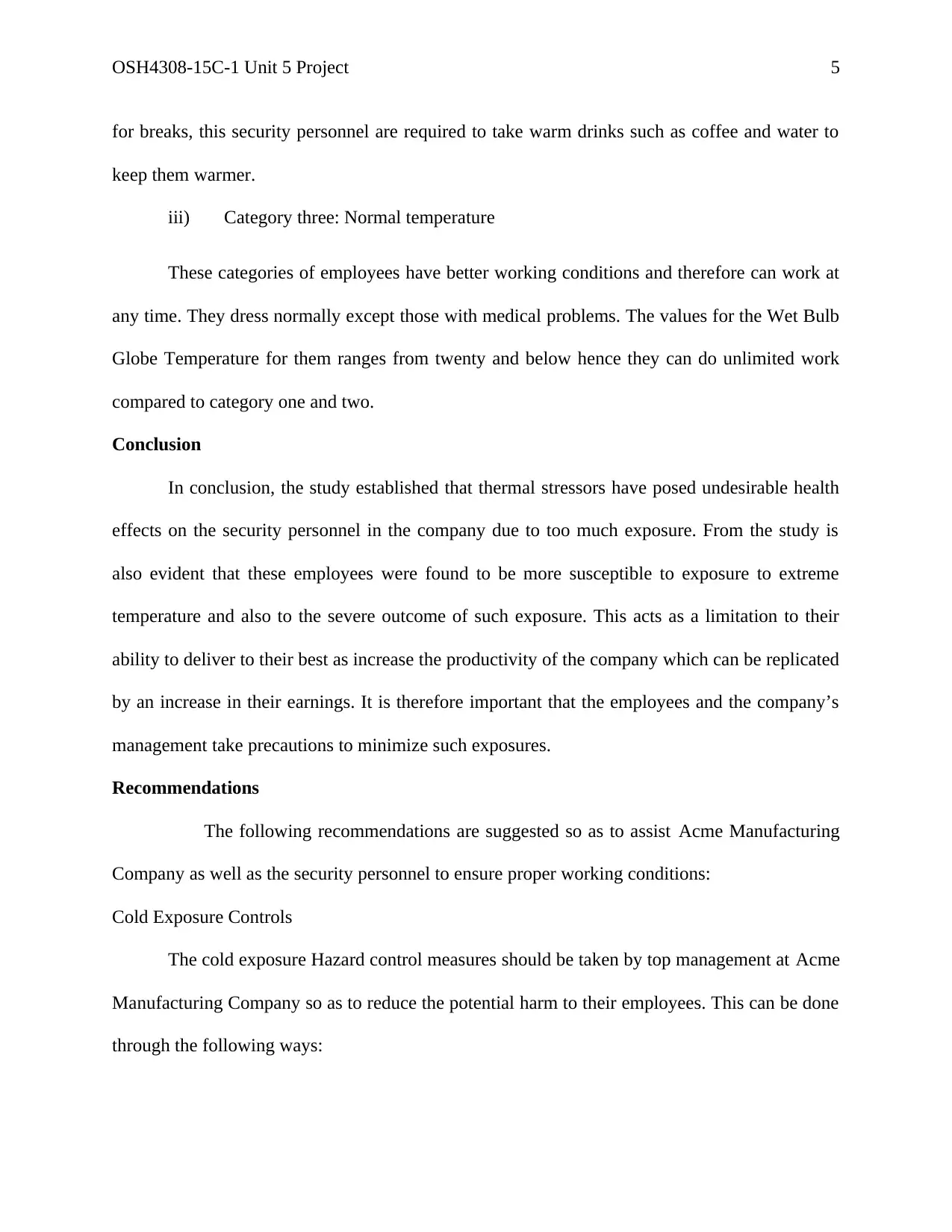
OSH4308-15C-1 Unit 5 Project 5
for breaks, this security personnel are required to take warm drinks such as coffee and water to
keep them warmer.
iii) Category three: Normal temperature
These categories of employees have better working conditions and therefore can work at
any time. They dress normally except those with medical problems. The values for the Wet Bulb
Globe Temperature for them ranges from twenty and below hence they can do unlimited work
compared to category one and two.
Conclusion
In conclusion, the study established that thermal stressors have posed undesirable health
effects on the security personnel in the company due to too much exposure. From the study is
also evident that these employees were found to be more susceptible to exposure to extreme
temperature and also to the severe outcome of such exposure. This acts as a limitation to their
ability to deliver to their best as increase the productivity of the company which can be replicated
by an increase in their earnings. It is therefore important that the employees and the company’s
management take precautions to minimize such exposures.
Recommendations
The following recommendations are suggested so as to assist Acme Manufacturing
Company as well as the security personnel to ensure proper working conditions:
Cold Exposure Controls
The cold exposure Hazard control measures should be taken by top management at Acme
Manufacturing Company so as to reduce the potential harm to their employees. This can be done
through the following ways:
for breaks, this security personnel are required to take warm drinks such as coffee and water to
keep them warmer.
iii) Category three: Normal temperature
These categories of employees have better working conditions and therefore can work at
any time. They dress normally except those with medical problems. The values for the Wet Bulb
Globe Temperature for them ranges from twenty and below hence they can do unlimited work
compared to category one and two.
Conclusion
In conclusion, the study established that thermal stressors have posed undesirable health
effects on the security personnel in the company due to too much exposure. From the study is
also evident that these employees were found to be more susceptible to exposure to extreme
temperature and also to the severe outcome of such exposure. This acts as a limitation to their
ability to deliver to their best as increase the productivity of the company which can be replicated
by an increase in their earnings. It is therefore important that the employees and the company’s
management take precautions to minimize such exposures.
Recommendations
The following recommendations are suggested so as to assist Acme Manufacturing
Company as well as the security personnel to ensure proper working conditions:
Cold Exposure Controls
The cold exposure Hazard control measures should be taken by top management at Acme
Manufacturing Company so as to reduce the potential harm to their employees. This can be done
through the following ways:
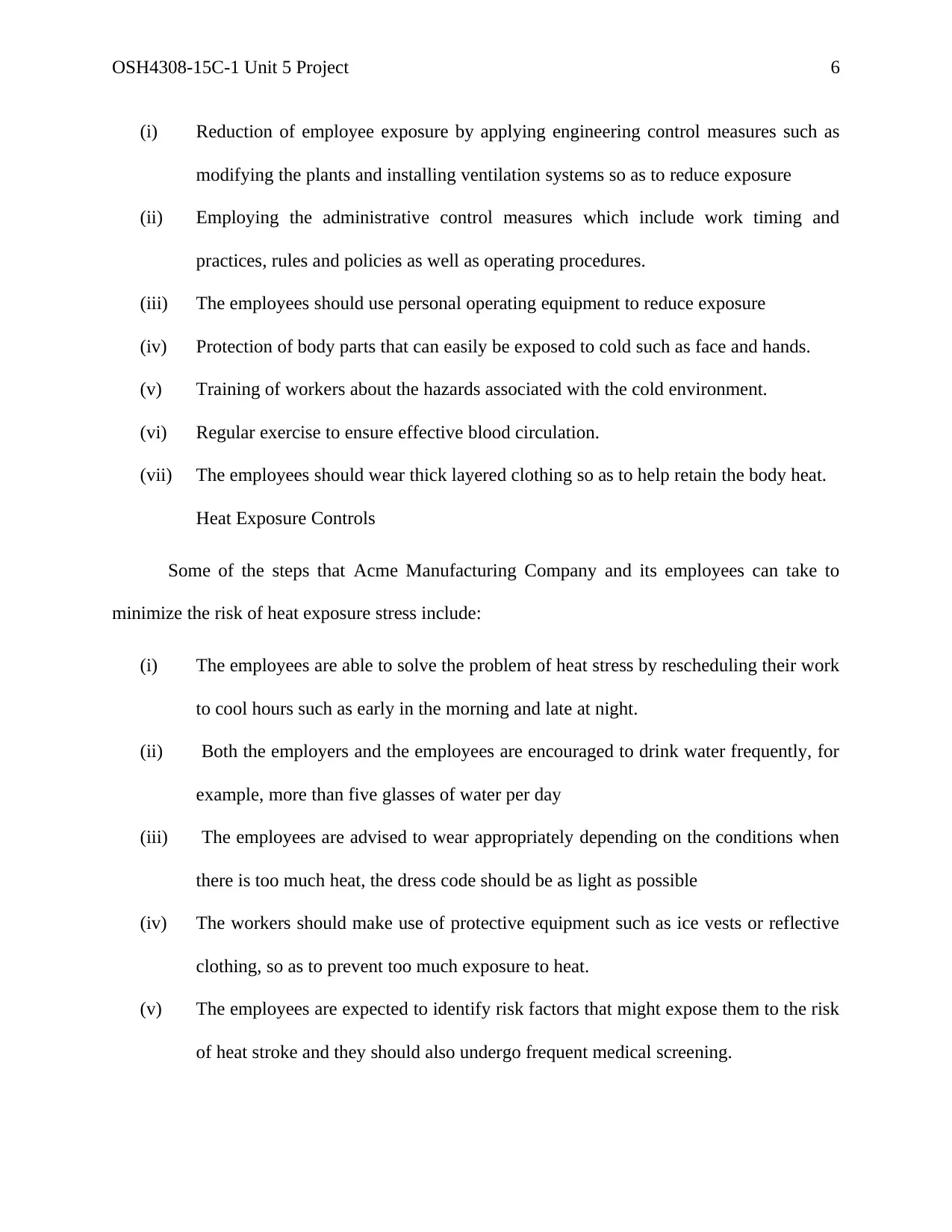
OSH4308-15C-1 Unit 5 Project 6
(i) Reduction of employee exposure by applying engineering control measures such as
modifying the plants and installing ventilation systems so as to reduce exposure
(ii) Employing the administrative control measures which include work timing and
practices, rules and policies as well as operating procedures.
(iii) The employees should use personal operating equipment to reduce exposure
(iv) Protection of body parts that can easily be exposed to cold such as face and hands.
(v) Training of workers about the hazards associated with the cold environment.
(vi) Regular exercise to ensure effective blood circulation.
(vii) The employees should wear thick layered clothing so as to help retain the body heat.
Heat Exposure Controls
Some of the steps that Acme Manufacturing Company and its employees can take to
minimize the risk of heat exposure stress include:
(i) The employees are able to solve the problem of heat stress by rescheduling their work
to cool hours such as early in the morning and late at night.
(ii) Both the employers and the employees are encouraged to drink water frequently, for
example, more than five glasses of water per day
(iii) The employees are advised to wear appropriately depending on the conditions when
there is too much heat, the dress code should be as light as possible
(iv) The workers should make use of protective equipment such as ice vests or reflective
clothing, so as to prevent too much exposure to heat.
(v) The employees are expected to identify risk factors that might expose them to the risk
of heat stroke and they should also undergo frequent medical screening.
(i) Reduction of employee exposure by applying engineering control measures such as
modifying the plants and installing ventilation systems so as to reduce exposure
(ii) Employing the administrative control measures which include work timing and
practices, rules and policies as well as operating procedures.
(iii) The employees should use personal operating equipment to reduce exposure
(iv) Protection of body parts that can easily be exposed to cold such as face and hands.
(v) Training of workers about the hazards associated with the cold environment.
(vi) Regular exercise to ensure effective blood circulation.
(vii) The employees should wear thick layered clothing so as to help retain the body heat.
Heat Exposure Controls
Some of the steps that Acme Manufacturing Company and its employees can take to
minimize the risk of heat exposure stress include:
(i) The employees are able to solve the problem of heat stress by rescheduling their work
to cool hours such as early in the morning and late at night.
(ii) Both the employers and the employees are encouraged to drink water frequently, for
example, more than five glasses of water per day
(iii) The employees are advised to wear appropriately depending on the conditions when
there is too much heat, the dress code should be as light as possible
(iv) The workers should make use of protective equipment such as ice vests or reflective
clothing, so as to prevent too much exposure to heat.
(v) The employees are expected to identify risk factors that might expose them to the risk
of heat stroke and they should also undergo frequent medical screening.
⊘ This is a preview!⊘
Do you want full access?
Subscribe today to unlock all pages.

Trusted by 1+ million students worldwide
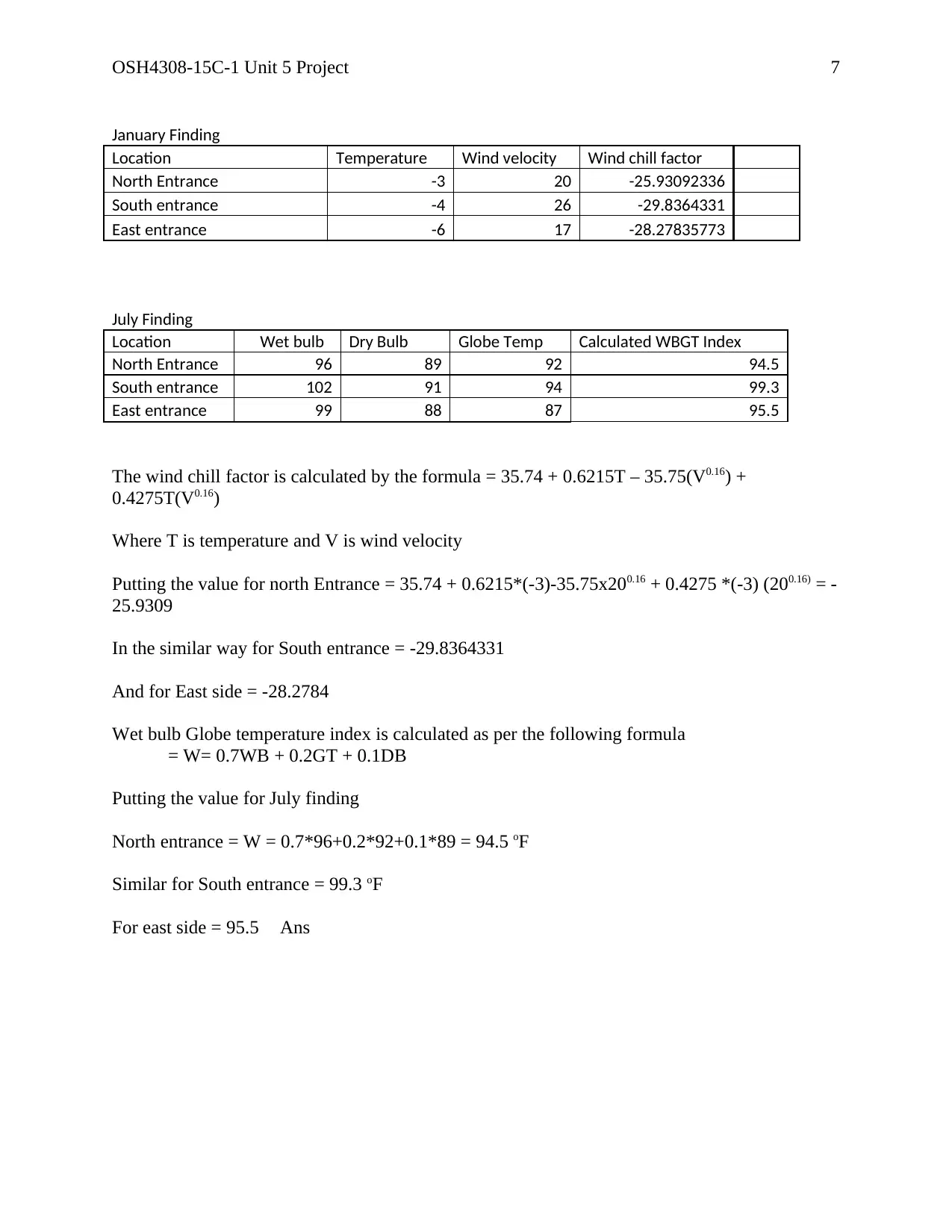
OSH4308-15C-1 Unit 5 Project 7
January Finding
Location Temperature Wind velocity Wind chill factor
North Entrance -3 20 -25.93092336
South entrance -4 26 -29.8364331
East entrance -6 17 -28.27835773
July Finding
Location Wet bulb Dry Bulb Globe Temp Calculated WBGT Index
North Entrance 96 89 92 94.5
South entrance 102 91 94 99.3
East entrance 99 88 87 95.5
The wind chill factor is calculated by the formula = 35.74 + 0.6215T – 35.75(V0.16) +
0.4275T(V0.16)
Where T is temperature and V is wind velocity
Putting the value for north Entrance = 35.74 + 0.6215*(-3)-35.75x200.16 + 0.4275 *(-3) (200.16) = -
25.9309
In the similar way for South entrance = -29.8364331
And for East side = -28.2784
Wet bulb Globe temperature index is calculated as per the following formula
= W= 0.7WB + 0.2GT + 0.1DB
Putting the value for July finding
North entrance = W = 0.7*96+0.2*92+0.1*89 = 94.5 oF
Similar for South entrance = 99.3 oF
For east side = 95.5 Ans
January Finding
Location Temperature Wind velocity Wind chill factor
North Entrance -3 20 -25.93092336
South entrance -4 26 -29.8364331
East entrance -6 17 -28.27835773
July Finding
Location Wet bulb Dry Bulb Globe Temp Calculated WBGT Index
North Entrance 96 89 92 94.5
South entrance 102 91 94 99.3
East entrance 99 88 87 95.5
The wind chill factor is calculated by the formula = 35.74 + 0.6215T – 35.75(V0.16) +
0.4275T(V0.16)
Where T is temperature and V is wind velocity
Putting the value for north Entrance = 35.74 + 0.6215*(-3)-35.75x200.16 + 0.4275 *(-3) (200.16) = -
25.9309
In the similar way for South entrance = -29.8364331
And for East side = -28.2784
Wet bulb Globe temperature index is calculated as per the following formula
= W= 0.7WB + 0.2GT + 0.1DB
Putting the value for July finding
North entrance = W = 0.7*96+0.2*92+0.1*89 = 94.5 oF
Similar for South entrance = 99.3 oF
For east side = 95.5 Ans
Paraphrase This Document
Need a fresh take? Get an instant paraphrase of this document with our AI Paraphraser
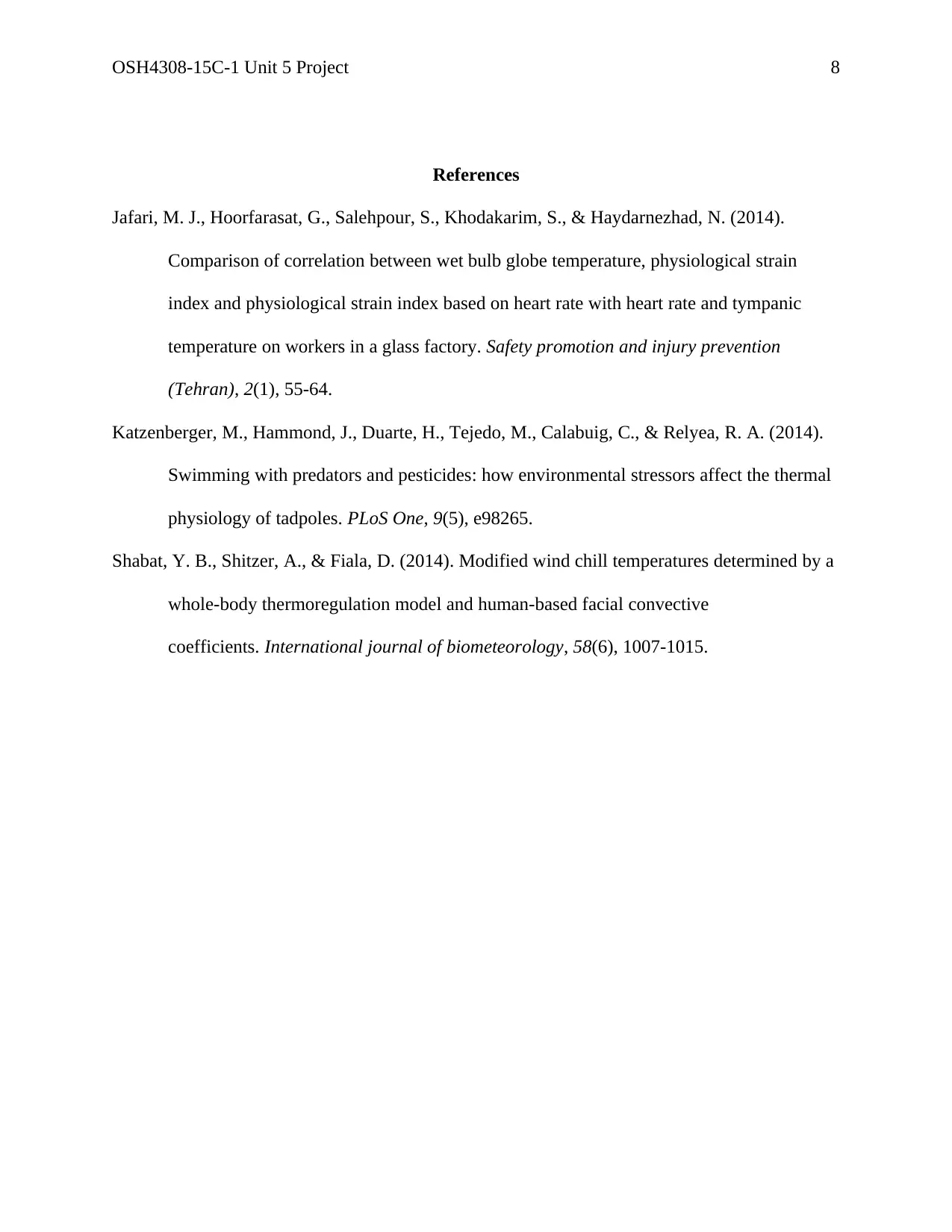
OSH4308-15C-1 Unit 5 Project 8
References
Jafari, M. J., Hoorfarasat, G., Salehpour, S., Khodakarim, S., & Haydarnezhad, N. (2014).
Comparison of correlation between wet bulb globe temperature, physiological strain
index and physiological strain index based on heart rate with heart rate and tympanic
temperature on workers in a glass factory. Safety promotion and injury prevention
(Tehran), 2(1), 55-64.
Katzenberger, M., Hammond, J., Duarte, H., Tejedo, M., Calabuig, C., & Relyea, R. A. (2014).
Swimming with predators and pesticides: how environmental stressors affect the thermal
physiology of tadpoles. PLoS One, 9(5), e98265.
Shabat, Y. B., Shitzer, A., & Fiala, D. (2014). Modified wind chill temperatures determined by a
whole-body thermoregulation model and human-based facial convective
coefficients. International journal of biometeorology, 58(6), 1007-1015.
References
Jafari, M. J., Hoorfarasat, G., Salehpour, S., Khodakarim, S., & Haydarnezhad, N. (2014).
Comparison of correlation between wet bulb globe temperature, physiological strain
index and physiological strain index based on heart rate with heart rate and tympanic
temperature on workers in a glass factory. Safety promotion and injury prevention
(Tehran), 2(1), 55-64.
Katzenberger, M., Hammond, J., Duarte, H., Tejedo, M., Calabuig, C., & Relyea, R. A. (2014).
Swimming with predators and pesticides: how environmental stressors affect the thermal
physiology of tadpoles. PLoS One, 9(5), e98265.
Shabat, Y. B., Shitzer, A., & Fiala, D. (2014). Modified wind chill temperatures determined by a
whole-body thermoregulation model and human-based facial convective
coefficients. International journal of biometeorology, 58(6), 1007-1015.
1 out of 8
Your All-in-One AI-Powered Toolkit for Academic Success.
+13062052269
info@desklib.com
Available 24*7 on WhatsApp / Email
![[object Object]](/_next/static/media/star-bottom.7253800d.svg)
Unlock your academic potential
Copyright © 2020–2025 A2Z Services. All Rights Reserved. Developed and managed by ZUCOL.